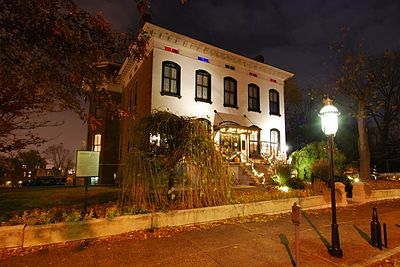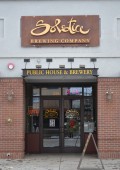American Ghost Stories III: The Lemp Family Suicides

One of America's most haunted places exists in the city of St. Louis. The Lemp Mansion has a long and tragic history. Lemp family patriarch, Adam Lemp, founded the Lemp Brewery in the early 1800s and made a good living my selling their beer, distilling vinegars and selling other wares at the Lemp's grocery. He and his wife moved into the mansion in 1876. They had a son named William in 1835. William was educated at St. Louis University and eventually took over the brewery operation. He built the business into a mini-empire, making it the largest single owned brewery outside of New York and was soon shipping beer around the world. The brewery became one of the most modern and expertly appointed breweries in the world. William and his wife had four sons. Each was included in family plan to eventually take over the Lemp Brewing Company, however in 1901, youngest son Frederick, whom many believed to be his father's favorite and his hand-picked successor, died of heart failure. He was only 28 years old. His death left his father despondent. His grief intensified following the death of his best friend and fellow brewer, Frederick Pabst, in 1904. Unable to cope with the demise of his son and friend, William Sr. shot himself in the head while lying in bed. His was the first in a long line of Lemp family suicides.
After William Sr.'s suicide, his daughter, Elsa Lemp Wright, was experiencing problems of her own. Mired in an unhappy marriage, Elsa filed for divorce in 1919. The couple eventually reconciled, but Elsa was plagued by health problems including chronic insomnia. Unable to cope with her sleep deprivation she shot herself in the heart while in the couple's bed.
William "Billy" Lemp Jr. had been running the brewery following his father's suicide, but over the years, he found himself more and more disengaged from the operations. It was likely that he was distracted by his eccentric wife, who had become known publicly as The Lavender Lady. She was said to have employed seamstresses to fashion her clothing exclusively out of lavender fabrics. In addition, she owned a fleet of horse carriages, one for each day of the week that were each appointed with lavender seating. Billy eventually filed for divorce from his wife, charging her with "the excessive wearing of the color lavender to attract public attention." For her part, The Lavender Lady charged her husband with threatening her with a gun and with having her beaten. Each charged the other with infidelity. Needless to day, their marital circus took its toll on the family brewery. As business began to suffer, Billy finally closed the brewery, eventually selling it at auction for a fraction of its original worth. He cleared less than $600,000 when a mere three years earlier it had been worth $7 million. Billy was eventually diagnosed with depression. Perhaps his depression led to the failure of the family business. It certainly led to Billy shooting himself in the heart as his sister and father had done.
Of the three Lemp suicides, none had left a note explaining their motives. It was not until William Sr.'s third son, Charles, committed suicide in 1949 that a note was left. Charles had left the family business in favor of a career in finance and politics. He was a bachelor that lived with his dog. He shot himself in the head in 1949, but despite having left a suicide note, it revealed no motive. It merely, read, "In case I am found dead, blame it on no one but me."
William Sr. and his wife had one other child, their second son, Edwin. Edwin was the one member of the family that seemed to maintain his sanity. He lived to be 90 years old.
With such a tragic history, it is not surprising that the Lemp mansion is considered to be one of the most haunted buildings in the United States. It has been described as a melancholy building in which items move on their own, a feeling that someone is watching hangs over the rooms, and apparitions of Lemp family members frighten visitors. Guests also tell of a pervasive smell of decayed human flesh. The mansion now houses a restaurant and inn. Tours are operated regularly in which guests learn of the Lemp family's devastating and tragic history.
More American Ghost Stories
- American Ghost Stories Part I: New Orlean's LaLaurie Mansion
American Ghost Stories Part I: Madame LaLaurie Several years ago I was in New Orleans and was lucky enough to enjoy one of their many ghost tours. My tour was led by a very gothic, vampire looking man,... - American Ghost Stories II - Marie LaVeaux
The Strange Tale of an American Voodoo Legend Marie Laveau was born in New Orleans' French Quarter as a free person of color in around 1794. She was a woman of mixed race whose father was a wealthy...
© 2011 Jaynie2000






